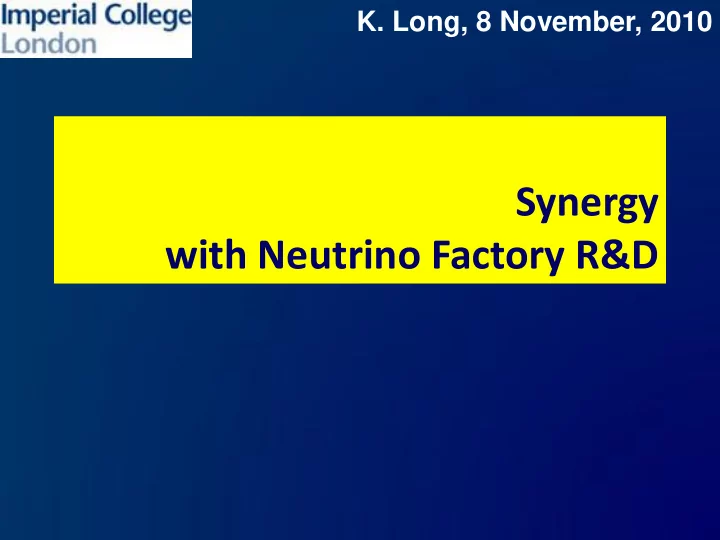

K. Long, 8 November, 2010 Synergy with Neutrino Factory R&D
Apologies and thanks: I would very much have liked to come to this workshop both to engage in the discussions and to make this contribution. Unfortunately, I have not been able to do this. I would like to apologise to Yoshi Kuno and the organisers for not being at the meeting and I would like to thank Ajit Kurup for presenting these slides on my behalf.
Contents: • The physics of flavour • Accelerator facilities • Conclusion and opportunity
Synergy with Neutrino Factory R&D: The Physics of Flavour
• Neutrino oscillations, an established phenomenon → Neutrino mass is not zero and neutrinos mix • i.e. Standard Model is incomplete → Either: • Majorana neutrino: a new state of matter; or • New physics: – To distinguish Dirac neutrino from Dirac anti-neutrino • Observations: – Neutrino mixing pattern substantially different to that of the quarks – Neutrino masses are tiny • Phenomenological description: – Mixing of mass states → flavour states • Potentially yields additional source of CP violation • Theory presently unable to offer explanations – Many ideas, many predictive, none established • Lepton-flavour physics is led by experiment! – Imperative: devise best experimental programme: • Best sensitivity for discovery, best precision on parameters
Synergy: • Neutrino oscillations: • Charged lepton flavour violation: • Related processes? – Again, many theories, in some there is strong relation between explanation of neutrino oscillations and CLFV, in others there is not – Experimentally led, therefore greatest benefit from combining: • Neutrino oscillations, CLFV searches, LFV at colliders • Can we articulate a ‘ muon programme’? – Definitive CLFV programme – Definitive neutrino oscillations programme – The route to the energy frontier in lepton-antilepton collisions
Synergy with Neutrino Factory R&D: Accelerator facilities
Overview:
Proton driver: • Requirements: COMET/Mu2e PRISM Neutrino Factory Power (kW) 56 750--2000 4000 Energy (GeV) 8 2--8 5--15 (8) 10 -9 Extinction Bunch length (ns) 100 10 2 • Short proton bunch length common requirement: – COMET/Mu2e: 100 ns ‘achievable’: – PRISM: 10 ns at high power, low energy requires development – Neutrino Factory: 2 ns at high power and low energy requires development • Chopping: – Also common requirement
Chopping/extinction: • Chopping: for preparation of linac beam for injection into synchrotron: – Development required (and in hand) for high- power beams (PRISM, Neutrino Factory, Muon Collider) • Extinction: – CLVF: background handling
Bunch compression: J. Pasternak • IDS-NF considering two generic options: – Rings: – LINAC: • Development option for J-PARC or RAL or possible • Possible development option ‘green - field’ option for SPL (CERN) or Project-X (FNAL) • Requires bunch compression • Requires accumulator/compressor rings M.Alba E.Benedetto J.Pasternak
Pion-production and capture: • Differences: – CLFV: capture backward-going pions – Neutrino Factory: capture in forward direction • Nevertheless, capture systems all based on high- field solenoids: SC-5 SC-2 SC-3 SC-4 Window SC-1 Nozzle Tube Mercury Drains Mercury Proton Pool Beam Water-cooled Tungsten Shield Mercury Jet Iron Splash Plug Resistive Mitigator Magnets ORNL/VG Mar2009
Muon-beam transport: • Muon beam is a tertiary beam: – Typically large emittance • Solenoidal transport common to CLFV, Neutrino Factory, and Muon Collider – COMET requirment: • ‘Twisted solenoids’ to introduce vertical dipole component – Possible application in Neutrino Factory front-end
Muon FFAG:
Injection/extraction:
Muon acceleration: E fin (GeV) Comment Change in g Pre-accel. Linac 0.9 RLA I 3.6 Switch-yard congestion Rapid acceleration! RLA II 12.6 Switch-yard congestion FFAG 25.0 Large acceptance, use of RF • Linac/RLAs: • Fixed Field Alternating Gradient (FFAG) accelerator: – Superconducting linac: – Large aperture magnets with • Large acceptance; fixed field: • Rapidly increase γ to • Continued rapid acceleration increase effective lifetime • Improved cost-efficiency in use of – Recirculating linacs (RLAs): RF – Injection/extraction challenging: • Continue rapid acceleration • Development of appropriate • More cost-effective use of RF schemes in progress IPAC10: WEPE060, THPEB035,THPE033, THPD093
T.Planche 3.6 — 12.5 GeV alternative: • Possibility of cost saving through use of an FFAG alternative to Linac/RLAs under study
Muon acceleration; 12.6 — 25 GeV FFAG: IPAC10: MOPEC043, MOPE085,WEPE057 • Lattice, including insertions, close to ‘freeze’; – Septum magnets, especially extraction septum, challenging
FFAG R&D: • FFAG machine R&D: – Osaka, Kurri: • Scaling FFAG machines for various applications – Daresbury Laboratory: • EMMA: non-scaling FFAG • Common interest: – Magnets: • Combined function, large aperture, etc. – Kickers: • Magnets, septa, power supplies and pulse-forming networks; – Opportunity to develop hardware demonstrators
Synergy with Neutrino Factory R&D: Conclusions and opportunity
Conclusions: • Scientific case for searches for charged-lepton flavour violation, which was always strong, now compelling in the light of emerging understanding of neutrino oscillations • Field of study of (lepton) flavour physics is experimentally led: – Implies the need to define the experimental programme most likely to: • Discover leptonic CP violation and CLFV • Determine the lepton mixing parameters with the requisite precision • Muon beams offer a rich, staged, particle physics programme that includes: – Increasingly sensitive searches for CLFV – Definitive measurements of neutrino oscillations – The route to the energy frontier in lepton-antilepton collisions
Opportunity: • Develop an internationally coordinated R&D activity that can deliver the benefits of this muon-physics programme Technology or capability Components and systems Concept development Failure mode analysis Target and collimator High-field magnets Ionisation cooling RF power sources Warm resonator Kicker/septum HiTc magnets S/c resonator Proton driver Linac/RLA FFAG Science and innovation Neutron Proton (LHC) Facility or application Neutrino SB COMET/Mu2e PRISM/PRIME Neutrino Factory Muon Collider Impact and society PBT ADSR Secturity
Recommend
More recommend